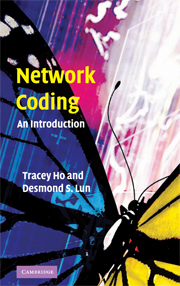3 - Inter–Session Network Coding
Published online by Cambridge University Press: 06 July 2010
Summary
So far, we have considered network coding for a single communication session, i.e., unicast communication to one sink node or multicast of common information to multiple sink nodes. This type of coding is called intra–session network coding, since we only code together information symbols that will be decoded by the same set of sink nodes. For intra–session network coding, it suffices for each node to form its outputs as random linear combinations of its inputs. Each sink node can decode once it has received enough independent linear combinations of the source processes.
When there are multiple sessions sharing the network, a simple practical approach is to allocate disjoint subsets of the network capacity to each session. If each session's allocated subgraph satisfies the max flow/min cut condition for each sink (Theorems 2.2 and 2.7), we can obtain a solution with intra–session network coding among information symbols of each session separately. Sections 5.1.1 and 5.2.1 discuss such an approach.
In general, however, achieving optimal rates may require inter–session network coding, i.e., coding among information symbols of different sessions. Inter–session network coding is more complicated than intra–session network coding. Coding must be done strategically in order to ensure that each sink can decode its desired source processes — nodes cannot simply combine all their inputs randomly, since the sink nodes may not have sufficient incoming capacity to decode all the randomly combined source processes. Unlike intra–session network coding, decoding may have to be done at non–sink nodes.
- Type
- Chapter
- Information
- Network CodingAn Introduction, pp. 49 - 64Publisher: Cambridge University PressPrint publication year: 2008



